For education & inspiration, here's the story of my 4 feet of vertical creek...
I have a little 1927 Spanish Revival bungalow in the suburban Silicon Valley sprawl just south of San Francisco. The backyard is meager - 35 feet x 40 feet (~10m x 12m) - so when I did it over, I decided to forgo water & work greedy grass, and make it into a little Santa Barbara style courtyard. At the centerish of the courtyard I put a fountain. I had no idea at the time how great a decision that would be. From the soothing, noise-covering songs it sings, to the constant stream of wildlife it brings, the fountain has proven to be a true garden delight.
Here's the before and after shots of my little backyard:
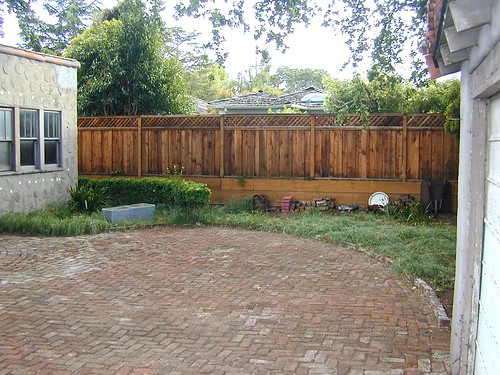
Before - it was a little undeveloped...
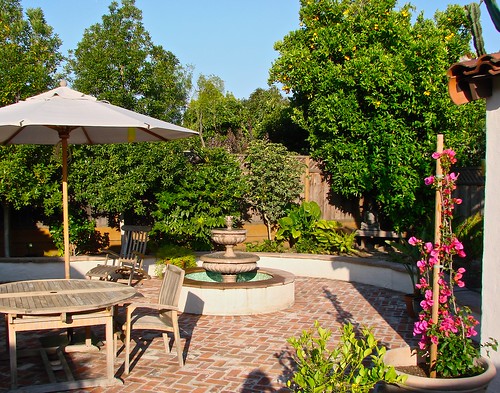
After - my Santa Barbara style courtyard w/ fountain
For the fountain, I bought on off-the-shelf cement A. Silvestri, and married it to a custom, built-in basin that was done with the patio and seat wall work in simple brick, sandstone & cement-stucco. The inside of the basin is classic colored 1" tiles. It has electricity, a water feed, and an overflow pipe coming up from the center in the bottom. The stack of 5 fountain pieces covers these inlets & outlets (while providing access to them at the base and a nook for the pump), and brings the total height to 50 inches with the tulip-shaped top piece on.
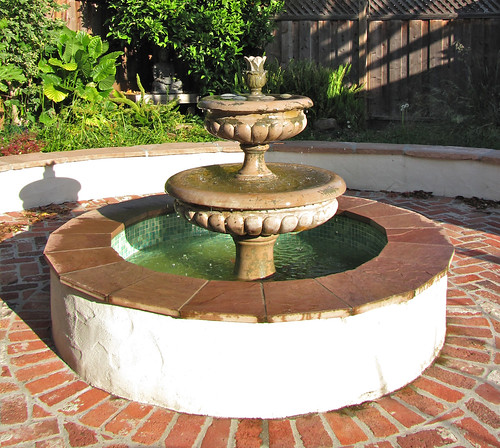
The full fountain in long morning light
==
Tranquil Trickles
The burbling and bubbling of the falling water was the top reason why I wanted a fountain. I've lived near creeks and oceans before, and know how soothing that sound can be - especially at night, when the air cools and keeps it from escaping upward. In fact, I can crack the window in my bedroom just an inch, and hear the trickles easily while in bed, and almost throughout the entire house, even though the fountain is a full 25 feet from the window.
The fountain's peaceful percolations also help mask the annoying noises that are typical in manicured suburban jungles like mine - e.g., mowers, blowers, trains, planes, cars, motorcycles, barking dogs, fighting cats, and the occasional screaming kids.
The sounds of my fountain:
==
Backyard Buddies
The tulip top proved to be an amazing and serendipitous feature. The small bowl and ledges formed by the petals makes it the perfect landing, drinking & bathing basin for small birds, such as finches, sparrows, flycatchers and hummers.
Aside from drinking & bathing in the tulip top, the birds also bathe on the edges where the water runs off the tiers. It can be quite hilarious to see them hunker down and splash around, while also flapping their wings to keep from slipping off. So, to create more surfaces for bird bathing, I added river rocks to the top basin:
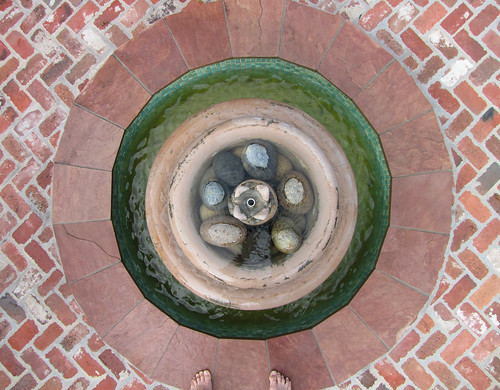
Didn't take the birds long to figure it out. Now they happily hop the rocks to find the perfect body-sized bowl for sitting and splashing.
Over the past year I've started taking pictures and keeping track of the various local critters that specifically visit my fountain. From birds to bugs to bumps in the night (raccoons - they leave their telltale little hand marks), it's quite popular.
Mammals:
Western Gray Squirrels drop by occasionally for a sip on hot days, and Raccoons sneak in at night to plumb the depths in hopes of finding tasty fish or frogs (but there aren't any).
Birds:
So far I've seen 11 species of birds visit the fountain: House Finches, House Sparrows, Lesser Goldfinches, Oak Titmouses, Bushtits, Bewick's Wrens, Black Phoebes, Cedar Waxwings, Western Scrub Jays, Ravens, and Mourning Doves.
Bugs:
Honey Bees stop for water on really hot days (when it's 90+), and dragonflies zip in now-and-again to see what might be around that's snack worthy.
Here's some of the fun fountain friend shots that I've taken while reading in the backyard, or by sneaking onto the porch (it helps to have a super zoom camera of course)...
The local, territorial Anna's Hummingbirds, Calypte anna, come daily to drink and bathe. Such as this stunning sweetheart:
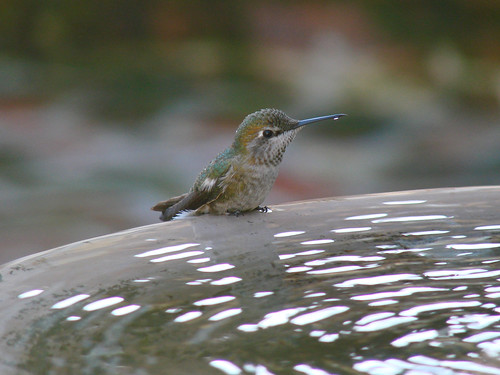
This handsome hummer boy comes in for drinks and baths too:
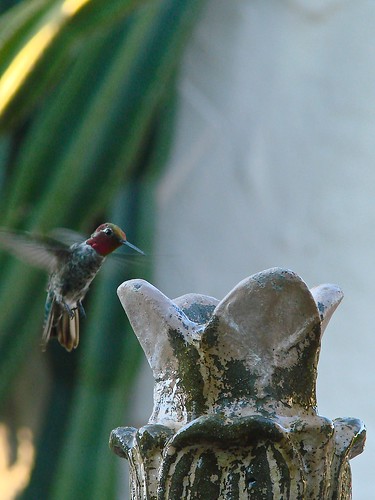
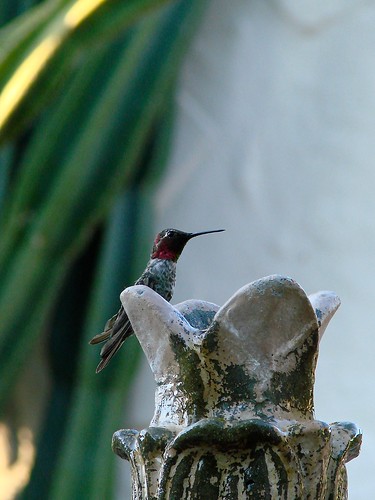
Sometimes they come in so fast it looks like they're expecting a tail hook...
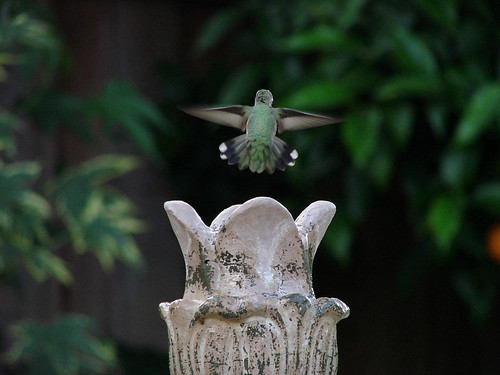
But they love their baths, and take several a day, doing their fluff-up air-dry in nearby trees:
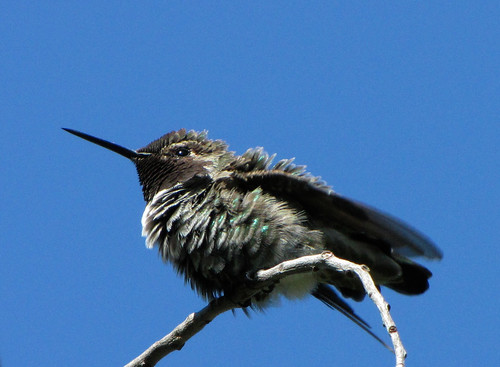
A local Black Phoebe, Sayornis nigricans, has also claimed my fountain as part of its territory and comes to bathe and bug hunt daily too. And yes, I call her "Phoebes" ala the TV show Friends - her constant cute peeps and tail flicks makes it somehow fitting. She looks like she could tweet a solid rendition of "Smelly Cat" as well:
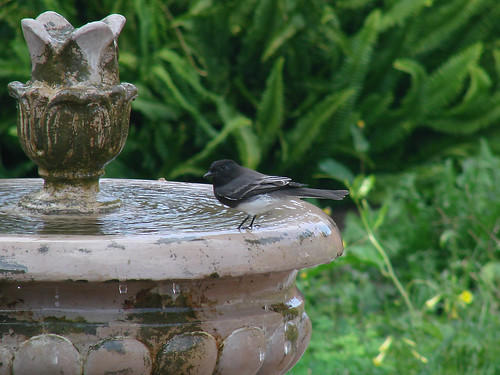
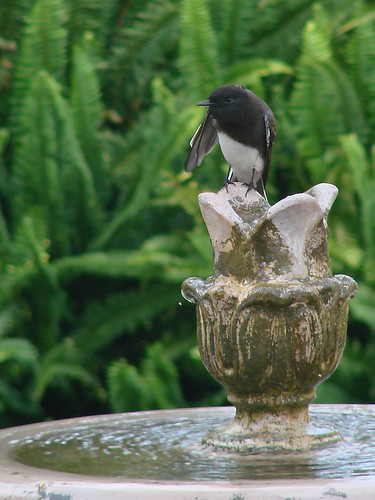
House Finches, Carpodacus mexicanus, flock in - sometimes in pairs, other times in droves. On hot days they come so often that you'd be hard-pressed to count double-digit minutes between visits. I've seen 11 on the fountain at once, while others queue in the trees for their turn:
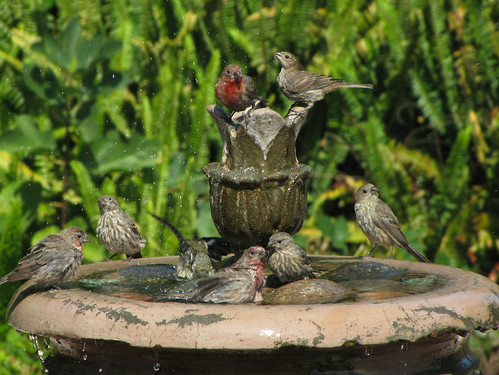

Here's one showing his bathing technique:
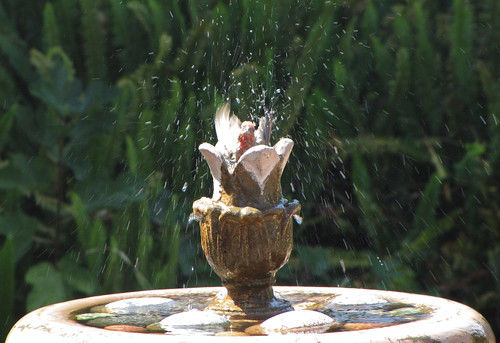

Lesser Goldfinches, Carduelis psaltria, also visit often. Many live in the area during Summer, but even so, it seems like the same ones fly in hourly for drinks and a bath - kinda like ultra-rich people to one of those 5-star spa towns:
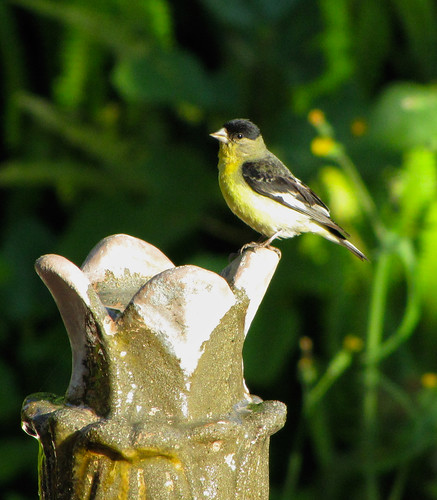
House Sparrows, Passer domesticus, stop by too, but not nearly as often or in the numbers of the finches - they're usually solo or in pairs:
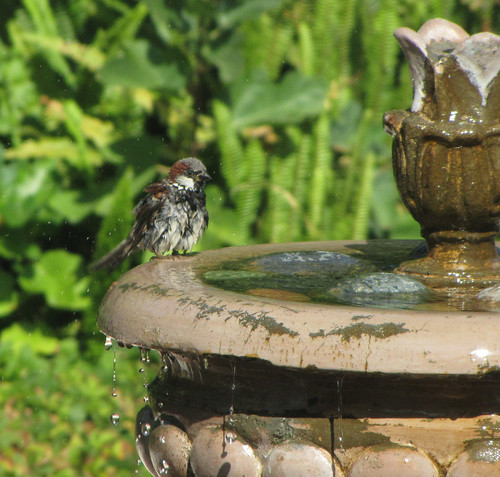
Here's a cobwebby Sparrow gal that nipped in for a gargle just after bug huntin' my cactus (hence the spider webs covering her face!):
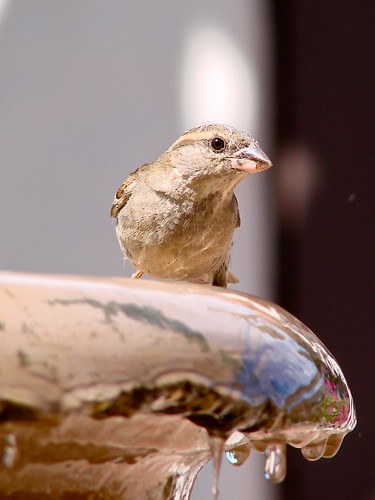
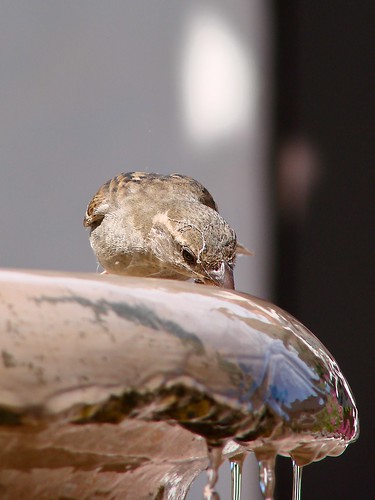
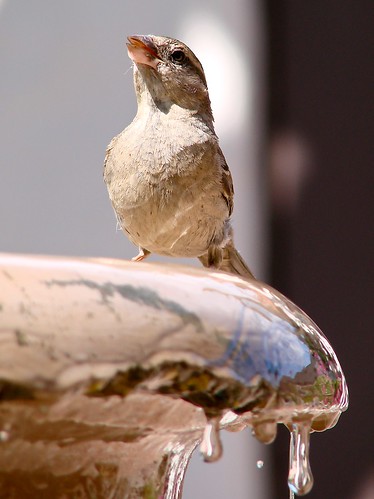
A pair of local Oak Titmouses, Baeolophus inornatus, also come for baths, one staying up in the trees to keep watch while the other has their fun:
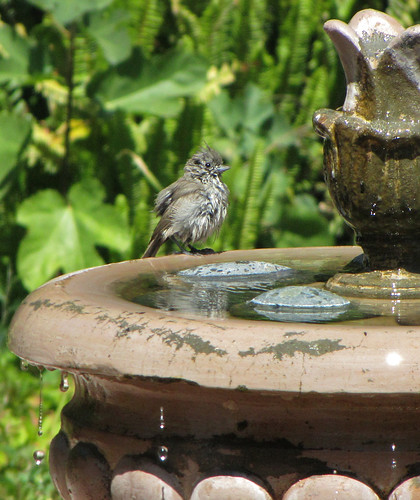
Color-coordinating Mourning Doves, Zenaida macroura, drop in for drinks now & again too:
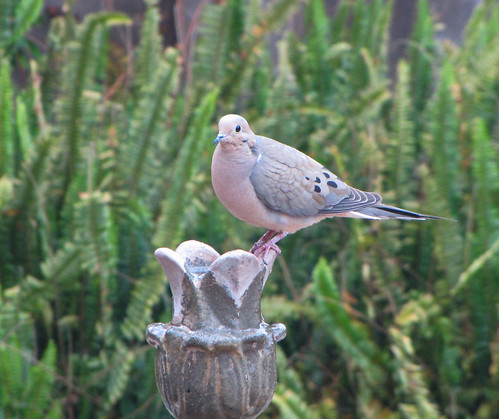
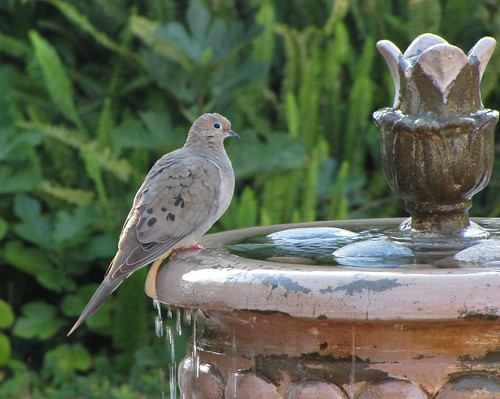
And, The Shadow knows my fountain:
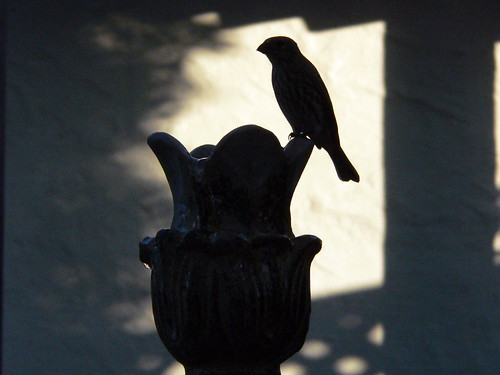
==
Maintenance and other nuts & bolts
Mosquitoes
To keep the fountain from becoming a breeding ground for mosies, I use Microbe-Lift Biologic Mosquito Control. I started off using the classic mosquito dunks, but once I found the Microbe-Lift, it became my go-to. It's just soooo easy, and there's no residue or floating eye-sore donuts. You just put in a few drops each week, and no mosquitoes will ever bloom. It does this by leveraging a bacteria called bacillus thuringiensis ssp. israelensis to kill any larvae that are born in the water. The bacteria infect the larvae, and within 24 hours the larvae's guts clog and they die. Problem solved. And it's safe for people, pets, fish & fowl - it only affects mosquitoes!
Keeping it clean
Because so many animals and insects visit the fountain, the only chemical I add is the safe mosquito blocker. I've tried the algaecide Fountec before, and it works pretty well for blasting algae, clarifying the water, and keeping the tiles clean, but I prefer to go with a little extra work and "the natural look" over pouring chems into it to keep it pretty. Fountec says it's fine for birds and pets though (but not for fish), so is a good option if you want a cleaner look.
As for that extra work cleaning the fountain, I do it in various ways. If I wanna do a big scrub, I sump-pump the water out, and go over it with a brush. Takes about an hour, and I typically do it twice a year - during Summer and after Winter. Most often though (monthlyish), I just spray it down to clean off the surfaces, and then use a fine net to scoop out the floating debris.
Water use & loss
The fountain holds about 120 gallons of water. Aside from water used & lost during cleaning, the fountain also loses water from evaporation, oversplash, and bird sips. At worse, in the height of Summer, it can lose 3-4 gallons per day (the rough equiv of a toilet flush). In Fall & Winter, it loses much, much less or even goes up (no evaporation, and it catches rainfall).
I can actually control the loss somewhat by decreasing the water flow rate (and thus the amount that's splashing per minute), but I prefer to tune for perfect sound and just add a little water weekly. Overall, the water cost at peak Summer use is less than 50 cents per month, and averages to about 30 cents per month for the whole year.
Electricity usage
The fountain is driven by a Little Giant PE-1, 1/125 HP, 36 watt pump. I have it on a standard timer that allows me to run it in chunks of time, but I tend to leave it going 24/7 to help keep the water clean and oxygenated for the local wildlife. As a result, my electricity cost to run the system is about $3.00 per month. I've been looking at solar panel driven pumps though (with batteries), so this cost may be eliminated in the future.
Total rough costs
Not counting my time, the average approximate maintenance cost for the fountain, including water, electricity and mosquito killer, is about $4.00 per month. Half the cost of a movie, and I get a show all day and everyday - now that's a bargain.
If I did it again?
If I did it again, about the only thing I'd probably change is the diameter of the basin. If it was just a little bit bigger, it would catch much more of the oversplash, and probably cut my water loss by half. I could put in a float-style water level sensor connected to a valve on the fill line to continuously top it up, but that seems like overkill. It'd be nice not to worry about getting water added while I'm on long vacations though.
In summary...
If you find delight in watching wildlife and don't constantly feel like you need to pee when you hear trickling water, then get yourself a water feature. But don't do it near my house - I don't want the competition for my backyard buddies!
====
References:
Ecological Labratories Inc. - Microbe-Lift Biologic Mosquito Control
McGrayel Company - Fountec Fountain Algaecide-Clarifier
Elizabeth Mcmillian - Casa California
A. Silvestri - Statuary & Fountains
Little Giant - Little Giant PE-1 1/125 HP 36W Pump
==========

That's an overall amazing job! I am inspired!
ReplyDelete